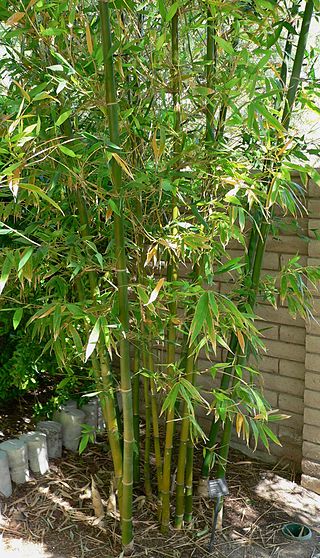
Bambusa is a large genus of clumping bamboos. Most species of Bambusa are rather large, with numerous branches emerging from the nodes, and one or two much larger than the rest. The branches can be as long as 11 m (35 ft).

Pleioblastus is an East Asian genus of monopodial bamboos in the grass family Poaceae. They are native to China and Japan, and naturalized in scattered places in Korea, Europe, New Zealand, and the Western Hemisphere.

Indocalamus is a genus of about 35 species of flowering plants in the grass family (Poaceae), native to China, Vietnam and Japan. They are quite small evergreen bamboos normally up to 2 m (6.6 ft) in height, initially forming clumps and then spreading to form larger thickets. They have thick, glossy leaves. Ruo leaves use to wrap foods like rice during dragon boat festival, originate in fujian refer to Indocalamus longiauritusoriginally but now are nonspecific to just about any leaf wrap.

Pseudosasa is a genus of East Asian bamboo in the grass family.
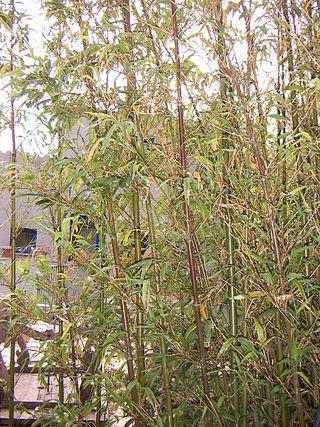
Semiarundinaria is a genus of East Asian bamboo in the grass family.

Sinobambusa is a genus of East Asian bamboo in the grass family. It is native to China and Vietnam. Sinobambusa tootsik also occurs in Japan, having been introduced there during the Tang Dynasty (618–907).
- Sinobambusa baccanensisT.Q.Nguyen – Vietnam
- Sinobambusa farinosa(McClure) T.H.Wen – Fujian, Guangdong, Guangxi, Jiangxi, Zhejiang
- Sinobambusa henryi(McClure) C.D.Chu & C.S.Chao – Guangdong, Guangxi
- Sinobambusa humilaMcClure – Guangdong
- Sinobambusa incanaT.H.Wen – Guangdong
- Sinobambusa intermediaMcClure – Fujian, Guangdong, Guangxi, Sichuan, Yunnan
- Sinobambusa nephroauritaC.D.Chu & C.S.Chao – Guangdong, Guangxi, Sichuan
- Sinobambusa rubroligulaMcClure – Guangdong, Guangxi, Hainan
- Sinobambusa sat(Balansa) C.S.Chao & Renvoize – Vietnam
- Sinobambusa scabridaT.H.Wen – Guangxi
- Sinobambusa solearis(McClure) T.Q.Nguyen – Vietnam
- Sinobambusa tootsik(Makino) Makino ex Nakai – Fujian, Guangdong, Guangxi, Vietnam; naturalized in Japan including Ryukyu Islands
- Sinobambusa yixingensisC.S.Chao & K.S.Xiao – Jiangsu

Thamnocalamus is a genus of clumping bamboo in the grass family. These species are found from the Himalayas as well as Madagascar and Southern Africa.

Osmanthus is a genus of about 30 species of flowering plants in the family Oleaceae. Most of the species are native to eastern Asia ,and was originally found in the middle east of the Himalayas, with a few species from the Caucasus, New Caledonia, and Sumatra. Osmanthus has been known in China since ancient times with the earliest writings coming from the Warring States period; the book Sea and Mountain. South Mountain states: "Zhaoyao Mountain had a lot of Osmanthus".

Triadica is a plant genus of the family Euphorbiaceae first described as a genus in 1790. It is native to eastern southeastern, and southern Asia.
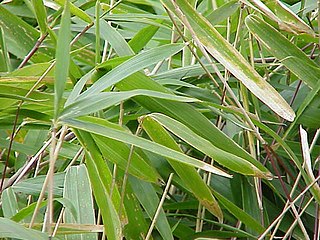
Arundinarieae is a tribe of bamboo in the grass family (Poaceae) containing a single subtribe, Arundinariinae, and 31 genera. These woody bamboos occur in areas with warm temperate climates in southeastern North America, Subsaharan Africa, South Asia and East Asia. The tribe forms a lineage independent of the tropical woody bamboos (Bambuseae) and the tropical herbaceous bamboos (Olyreae).
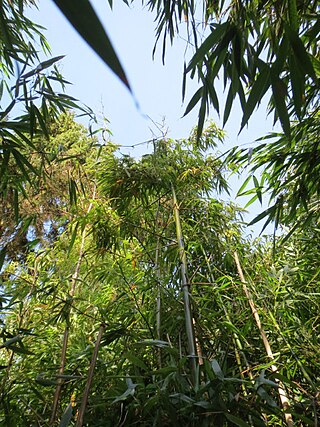
Oligostachyum is a genus of bamboo in the grass family, native to coastal China.

Lophatherum is a genus of Asian and Australian plants in the grass family.

Eremochloa is a genus of Asian and Australian plants in the grass family.

Neyraudia is a genus of Asian and African plants in the grass family.
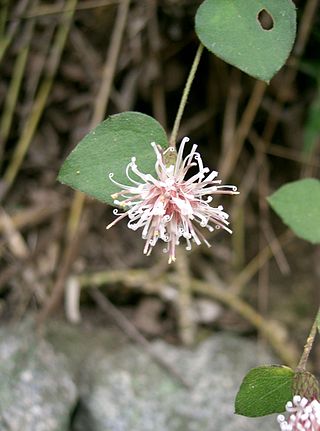
Pertya is a genus of Asian flowering plants in the family Asteraceae.
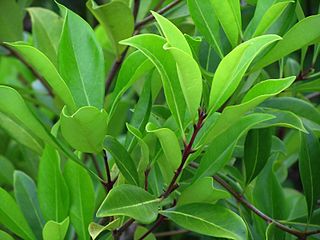
Cartrema is a genus of a few species of flowering plants in the family Oleaceae, native to southeastern Asia, southern China, and North America, formerly treated as section Leiolea of Osmanthus. Species of Cartrema may be distinguished from those of Osmanthus by the paniculate inflorescences of the former.

Disporopsis is a genus of plants in the Asparagaceae. It is native to China, Indochina and the Philippines.
- Disporopsis aspersa(Hua) Engl. ex Diels - Guangxi, Hubei, Hunan, Sichuan, Yunnan
- Disporopsis bakerorumFloden, Yunnan
- Disporopsis bodinieri(H.Lév.) Floden China to N. Vietnam
- Disporopsis fuscopictaHance - Philippines, Fujian, Guangdong, Guangxi, Guizhou, Hunan, Jiangxi, Sichuan, Yunnan
- Disporopsis jinfushanensisZ.Y.Liu - Sichuan
- Disporopsis longifoliaCraib - Laos, Thailand, Vietnam, Guangxi, Yunnan
- Disporopsis luzoniensis(Merr.) J.M.H.Shaw - Luzon
- Disporopsis pernyi(Hua) Diels - Guangdong, Guangxi, Guizhou, Hunan, Jiangxi, Sichuan, Taiwan, Yunnan, Zhejiang
- Disporopsis undulataTamura & Ogisu - Sichuan
- Disporopsis yuiFloden China (Yunnan) to N. Myanmar.

Mosla is a genus of plants in the family Lamiaceae, first described as a genus in 1875. It is native to eastern Asia, the Himalayas, and southeastern Asia.
- Mosla bracteataDoan ex Suddee & A.J.Paton - Vietnam
- Mosla cavalerieiH.Lév.- Vietnam, Guangdong, Guangxi, Guizhou, Hubei, Jiangxi, Sichuan, Yunnan, Zhejiang
- Mosla chinensisMaxim. - Vietnam, Korea, Japan, Anhui, Fujian, Guangdong, Guangxi, Guizhou, Hubei, Hunan, Jiangsu, Jiangxi, Shandong, Sichuan, Taiwan, Zhejiang
- Mosla coreanaH.Lév. - Korea
- Mosla dianthera(Buch.-Ham. ex Roxb.) Maxim. - China, Japan, Korea, Ryukyu Islands, Kuril Islands, Primorye, Caucasus, Himalayas, Myanmar, Vietnam, Philippines, Sumatra
- Mosla exfoliata(C.Y.Wu) C.Y.Wu & H.W.Li - Sichuan
- Mosla hangchouensisMatsuda - Zhejiang
- Mosla japonica(Benth. ex Oliv.) Maxim. - Japan, Korea, Ryukyu Islands
- Mosla longibracteata(C.Y.Wu & S.J.Hsuan) C.Y.Wu & H.W.Li - Guangxi, Zhejiang
- Mosla longispica(C.Y.Wu) C.Y.Wu & H.W.Li - Jiangxi
- Mosla pauciflora(C.Y.Wu) C.Y.Wu & H.W.Li - Guizhou, Hubei, Sichuan
- Mosla punctulataNakai - Korea, Taiwan, Japan, China
- Mosla scabra(Thunb.) C.Y.Wu & H.W.Li - Vietnam, Korea, Japan, Ryukyu Islands, Anhui, Fujian, Gansu, Guangdong, Guangxi, Henan, Hubei, Hunan, Jiangsu, Jiangxi, Liaoning, Shaanxi, Sichuan, Taiwan, Zhejiang
- Mosla soochouensisMatsuda - Anhui, Jiangsu, Jiangxi, Zhejiang
- Mosla tamdaoensisPhuong - Vietnam
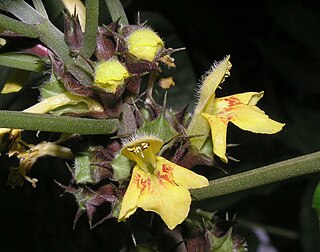
Paraphlomis is a genus of flowering plants in the mint family, Lamiaceae, first described in 1901. It is native to China, Himalayas, and Southeast Asia.

Microlepia is a genus of ferns in the family Dennstaedtiaceae described as a genus in 1836. Most of the species are native to Asia, with many endemic to China, although a few species occur also in Australia, Africa, the West Indies, Latin America, and various oceanic islands.




















